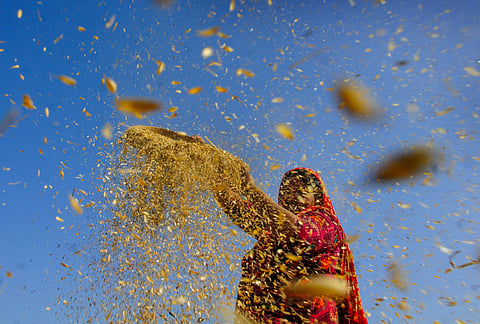

Agriculture is both a cause and victim of climate change. Agriculture at industrial scale has had a significant impact on water depletion and soil health. The leading international body for assessment of climate change, the IPCC, has estimated that the combined effect of agricultural activities is approximately one-fifth of the greenhouse effect caused by human action. The C02 amount in the Earth’s atmosphere is nearly 412 parts per million (ppm) today, which continues to rise. This represents a 47% increase since the beginning of the industrial age when the concentration was around 280 ppm and a 11% increase since 2000 when it was 370 ppm. Agricultural and allied activities such as rice cultivation, rearing of domestic animals and biomass burning account for 22–46% of the global methane concentration. Among these activities, paddy fields are the most important source, accounting for 15–20% of the world’s total methane emission caused due to human activities.
However, agriculture in many geographies, mostly in Africa, South Asia and Latin America, is characterised by fragmented land holding, ownership by small and marginal farmers, low capital investment, moderate-to-nil mechanisation and low productivity. The world’s economically poor communities are mostly concentrated in the same places. A World Bank Report on Climate Smart Agriculture (CSA) in 2020 indicates that the world will need about 70% more food by 2050 to feed an estimated 9 billion people.
Twelve years ago, the UN’s FAO launched the concept of CSA to holistically manage our farmland, livestock, forests and fisheries. The CSA is not esoteric. Bhutan has started focusing on high-value crops through mega-scale polyhouses with mobile-controlled smart irrigation. Such initiatives protect crops from windstorms and hailstorms. Farmers in the Philippines are receiving real-time scientific advice from “Rice Crop Managers” on their smartphones to make informed decisions to reduce vulnerabilities. Zimbabwe, a victim of prolonged droughts (1950–2013), has now adopted drought-resistant grain such as millets, sorghum and cassava as an initiative under the CSA. The world’s top producer and exporter of coffee, Brazil, experienced droughts in 2020. In India, the use of drone-based spray for insecticides and pesticides to increase bio-efficiency has started in pilot mode.
On the eve of Makar Sankranti, the United Nations World Food Programme (UNWFP) and Odisha’s government joined hands to improve the food security of small and marginal farmers by strengthening their resilience to climate change. Odisha envisages developing suitable toolkits and modules. Based on a pilot initiative, climate-change professionals shall guide the small and marginal farmers to transform farming practices and resort to alternative livelihood options based on climate risk, thus improving their household income and food security.
The remote forested hills of Odisha’s Malkangiri are a high rainfall area lately experiencing flash floods and landslides. A group of Bonda women farmers who have been exposed to climate risk are reaping diverse benefits from their indigenous climate-smart crops. According to a NITI Aayog study in 2020, Odisha recorded a 215% increase in gross value of millet produced per farmer household, from `3,957 in 2016–17 to `12,486 in 2018–19 and in the same period, the area under millet cultivation has increased from 2,949 hectares to 5,182 hectares and the yield rate has increased by 120%.
The women farmers are currently cultivating native millets that are climate resilient, reduce soil erosion, and ensure food and nutritional security for their community. This initiative is assisted by the Odisha Millets Mission, an initiative of the state government to improve food security. Before the Covid outbreak, women from 18 villages in Nayagarh district painted pots filled with seeds for Kharif season and marched to promote revival of the traditional practice of growing indigenous crops that are naturally pest-resistant and adaptive to climate disturbances. The women exchanged more than 200 varieties of seeds, which was a tradition in the hilly areas to maintain crop diversity.
Another climate fighter is Saraju Nayak in Ganjam district. Ganjam has had to bear the brunt of successive cyclones like the super cyclone of 1999, Hudhud and Phailin, which destroyed standing crops, livestock and plantations. Saraju and other women farmers have been attempting to minimise the impact of cyclones on their farms by implementing practices learned from training imparted by the Central Institute of Women in Agriculture in Bhubaneswar. Growth and sale of green fodder as well as animal husbandry have now replaced paddy cultivation.
Elsewhere, Minushri Madhumita and Amrita Jagatdeo from Kalahandi district have developed solar-powered devices with IoTs to cover an entire surface of a water tank for distribution of fish feed and aeration with distributed levels of oxygen. This smart initiative is helping farmers increase fish and prawn productivity, resulting in increased household income. The World Bank Initiative-Odisha Integrated Irrigation Project for Climate Resilient Agriculture (OIIPCRA) launched in 2019 focuses on rehabilitation of water tanks, promotion of aquaculture practices and post-harvest management across 15 districts benefiting 1,25,000 families.
To address the issue of emission of greenhouse gases due to extensive paddy cultivation, Odisha has collaborated with the International Rice Research Institute (IRRI) to launch the project ClimatePRO. The farmers under this initiative shall use the mobile-based application ‘SeedCast’ to estimate seed demand for varieties of rice to be cultivated.
According to the Odisha Economic Survey (2020–21), agriculture and allied sectors are the mainstay of the economy since more than 60% of people depend on it for livelihood. Innovation and reform in agriculture sector administration are the key. For absorbing world-class ideas, Odisha has collaborated with international and national level NGOs and advocacy groups for evidence-based research and guidance of the field functionaries.
The state government’s awareness of the impending climate adversities stems from the fact that it has been faced with the stupendous task of relief and mitigation of natural calamities at regular intervals. The state agencies are tasked to spread locally viable indigenous farming, animal husbandry and agriculture practices in a sustainable way so that small and marginal farmers get remunerative returns.
Asit Tripathy, IAS (Retd)
Principal Advisor to the Odisha CM & Chairman, WODC